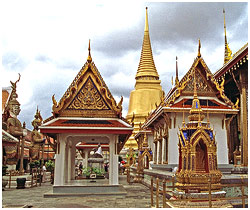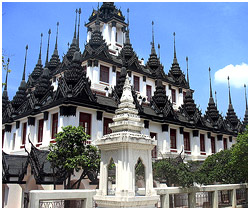These wats should be included in your travel itinerary for their sheer majesty and serenity. Besides, these places are open for everyone, whether religiously inclined or an agnostic. However, keep certain things in mind while visiting them. Take care not to hurt the religious sentiments of the Buddhist people by showing any kind of contempt or disrespect towards Buddha images and Buddhist monks. Avoid wearing sleeveless clothes and take off your shoes before entering the precincts of the main temple. Go through the following lines and get more information on some of the major Buddhist monasteries of Bangkok.
 Buddhist Temples of Bangkok
Buddhist Temples of BangkokWat Pho
Wat Pho is the largest wat in Bangkok and is famous for enshrining a beautiful gold-plated statue of the Reclining Buddha. With a length of 46 m and a height of 15 m, it is the largest reclining Buddha image in the whole Thailand. The feet and the eyes of the statue are embellished with mother-of-pearl decoration. Besides, the temple ground contains more than 1000 Buddha images, which is the maximum number of Buddha images housed by a monastery in Thailand
Wat Arun
Popularly known as the 'Temple of the Dawn', Wat Arun forms a major landmark of Bangkok and is located on the Thonburi side of the river. The temple features an elongated 'prang' (Khmer-style tower) and is encircled by four other smaller prangs. A Buddha image designed by King Rama II and some beautiful murals form major highlights of the place.
Wat Phra Kaeo
Wat Phra Kaeo or the 'Temple of the Emerald Buddha' is situated near the Grand Palace and is one of the most magnificent temples in Bangkok. Built in 1782, by King Rama I, the temple consists of more than 100 colorful buildings and golden spires. The Emerald Buddha in the temple is perched atop a gilded altar and stands shaded by a nine-tiered umbrella.
 Wat Benchamabophit
Wat BenchamabophitWat Benchamabophit or 'The Marble Temple' presents an excellent example of architectural and decorative ingenuity of Thai craftsmanship. Of special mention is the Ubosot Hall (Ordination Hall), which is distinctly neo-classical in style. Designed by H.R.H. Prince Narisranuvattivongse, the temple houses a Buddha image made from 2.5 tons of bronze.
Wat Saket
Wat Saket, with its Golden Mount (Golden Chedi), rests atop an artificial hill and is an important name among all the temples of Bangkok. Completed during the rule of King Rama IV, the Golden Mount enshrines a sacred relic of Buddha, given to the king by the British. Wat Saket also forms the venue for the Temple Fair of Bangkok, held in the month of October/ November every year.
Wat Ratchabophit
Built by King Rama V in 1869, Wat Ratchabophit is located on Fuang Nakhon Road, near Wat Pho. It shows a beautiful amalgamation of the traditional Thai as well as contemporary Western architectural styles and patterns. Its exteriors compliment the Thai style, whereas the interiors of the temple are distinctively European. There is a seated Lopburi-style Buddha image placed in the middle of the temple courtyard.



